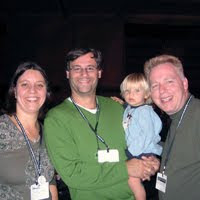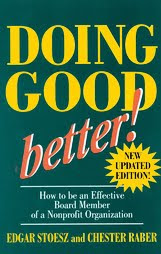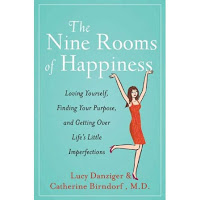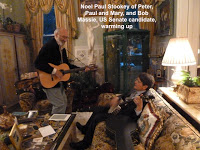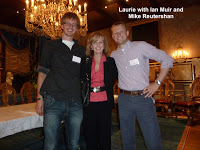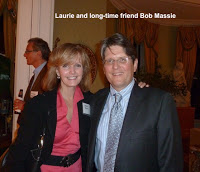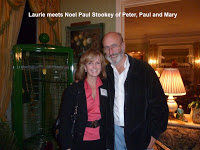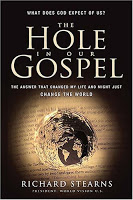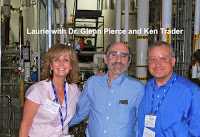
Every now and then I am reminded how wonderful it is to be a part of the hemophilia community, if you can say such a thing knowing it means your loved one has hemophilia! I spent the day on Friday with a group of dedicated colleagues, some I have known for 18 years, so many I admire. Our hemophilia community is filled with such people, all trying to improve the lives of those with the condition.
So I was honored to be selected to attend Biogen Idec Hemophilia’s first Advocacy Advisory Summit on Friday, in Research Triangle Park, North Carolina. Arriving to much-welcomed balmy weather, I caught up with a cast of great people and friends, including executive directors Lynne Capretto (Ohio), Sue Cowell (N. Carolina), Kevin Sorge (New England), Kelly Waters (Virginia), Merlin Wedepohl (N. Cal), Kristian Prill (Washington), Greg Mermilliod (S. Cal), Vicki Jackson (Alabama), Sean Hubbert (Central Cal), Ken Trader, Joe Kleiber and Michelle Rice of NHF, and Susan Swindle of HFA. And special guests Dolly Shinhat-Ross of WFH and Margo Price of ISTH.
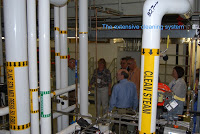
We were invited to “meet” Biogen Idec, learn about their clinical trials, and tour their plant. Jessica Swann, who many in our community know from her days as executive director of Hemophilia Association of San Diego, and then her days at Avigen and Bayer, is now Associate Director, Global Product and Market Development at Biogen Idec Hemophilia. She joins Dr. Glenn Pierce, Senior Vice President and Chief Medical Officer, who was twice president of NHF, formerly of Avigen and Bayer and who also formerly had hemophilia!
You may not recognize the name Biogen Idec: they do not have a commercial hemophilia product currently, but have two in the pipeline, in phase III clinical studies. You may have heard though about “extended half-life factor.” This is one company that is working on this.
When factor is infused into the blood stream to stop a bleed, it has a “half life.” Just as food is broken down and used, and you need to eat again, factor is used to stop bleeding and eventually broken down (degraded) in the blood stream and absorbed back into the body. The half life is how long it takes for 50% (half) of the factor to be used up. The idea behind extended half-life factor is to “catch” the factor when it is absorbed and return it back into the bloodstream before it gets degraded so it can still be used. Its half life then theoretically goes from 12-18 hours (currently normal half lives for factor) to up to 2-3 days or more. This may allow the protective effect of factor VIII and factor IX to last much longer than they currently last.
As a group, we tried to imagine what that would mean for patients: greater quality of life, fewer infusions, less stress and worry, greater protection. Make no mistake: extended half-life factor could be the next great thing in hemophilia.
Biogen is no stranger to me, but it is to our community because they did not continue its recombinant factor VIII program from 1982. It’s smart for any company to get familiar with the community before its product is launched. This company has a leg up as many of the people on its research, medical, clinical and marketing teams are from the community itself.
Still, Jess posed a question to our group of 35: How would you describe Biogen Idec? About 50% chose “Innovative,” while 19% chose “New and unknown player.” Yes, Biogen Idec is researching this new technology and new hemophilia products, but — who are you?
Biogen Idec is very familiar in the world of multiple sclerosis (MS). It has only three commercial products: Rituxan, Avonex (interferon beta), and Tysabri (natalizumab), which collectively had 2010 revenues of $4.7 billion. So it’s not a small company.But they have a big pipeline, with nine programs in Phase III (late stage) clinical studies, including extended half-life factor VIII and IX. Data just presented at ISTH in Japan this past summer looks promising.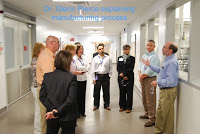
After listening in the morning to presentations by Biogen Idec executives about the company, its history, products and mission, we listened to quite compelling testimonials from two MS patients, and a local executive director of an MS society. Some of us were stunned to be on the “other side” of the testimonial telling: usually we are the ones giving the heart-wrenching testimonials. It was stirring and emotional to listen to an articulate mother tell her story of MS, and how the Biogen Idec drug helps her to live a normal life. She also related the patient assistance programs that help each person affected, and how she has counted on this help for 15 years! She most definitely put a face to the company in terms of practical and compassionate care.
After lunch we toured the manufacturing plant. This is always fascinating to me. None of us are scientists, and yet we have some idea of what goes on in making factor. But we get reminded when we tour plants of the years and years of research that goes into preparing for manufacturing, the quality control that must be in place, and above all the cleanliness of the environment. I think this struck us all the most. As Joe Kleiber of NHF commented, the “cleanliness and complexities” of large scale production of factor is astounding. 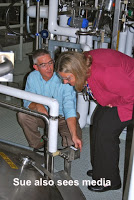

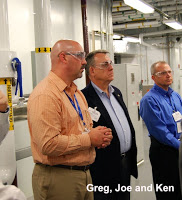

Steve, our tour guide, stressed how in making such a product, the process needs clean water and clean air. Quality control is paramount: they measure the concentration of microbes in the air; they reduce human contact with the manufacturing process as much as possible (humans carry bacteria, and we were to purify our hands many times on the tour); all reactors have to be sterilized each time a new batch is made. The process needs pure water, to make steam, to clean the pipes and parts. He showed us software that displayed continually how the current manufacturing process was measuring up, using 50 different measures all combined into one measure, compared to historical data. Looking at a line chart on a screen, you could actually see the current production and how it compared over past weeks to a historical line. In this way, you can make adjustments needed to get production back on track. This was fascinating to us!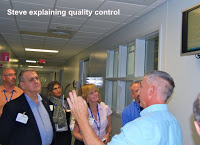
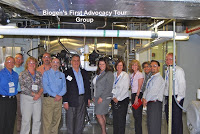
When we returned, we had many questions and the Biogen Idec team had questions for us. One piece of advice that was sincere and deep was not to overpromise the hemophilia community. New products are fantastic; we hunger for advanced products to help our children live more normal lives. But we have been burned in the past, when hopes were raised that a cure was around the corner.
The message was clear, for all companies: now that patents have expired and the race is on to bring new products to market, don’t build up hopes too high. Fortunately, we have great products now and our loved ones live good lives, especially compared to most other patients globally. We can wait and we want a realistic perspective. Still, there was excitement that a break-through product perhaps is not too far away.
In closing, Jess deftly asked us how we would now describe Biogen Idec? Not too surprisingly, almost everyone changed their original answer and selected, “Committed to the hemophilia community.”
I’d say that was a very successful first hemophilia Advocacy Advisory Summit.
For more info: www.biogenidechemophilia.com
Thanks to Biogen Idec for the tour and time, and thanks to all my colleagues who made for such a great meeting and day.
Good Book I Just Read
The Life You Can Save
Peter Singer
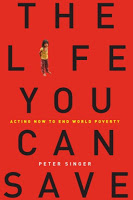
This compassionate and thought-provoking book on humanitarianism is nonetheless by a philosophy professor who once wrote that there is an argument to be made that aborting a fetus known to have hemophilia is not ethically wrong, in his book (which I have not read) Writings on an Ethical Life. I am not going there now, but will say this book was good. Singer’s very basic premise is that most of us would not hesitate to help a child drowning in a pool, even if it were inconvenient (missing a bus, ruining our clothes), but we blindly turn from the 27,000 children who die every day from preventable causes in developing countries. He sets his case well, wondering why we do not easily give up buying things we don’t need in order to help others to live. He explores our wariness with charitable organizations, and challenges our rationalizations for not giving. This is a good book, not without its flaws in the argument, but worth reading and a very quick read. Recommended for those who are compassionate, who want to influence others to be more compassionate and giving, and for those in healthcare globally. Three stars.
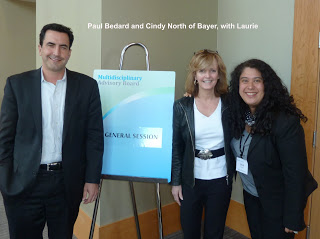
 Interesting Book I Just Read
Interesting Book I Just Read

